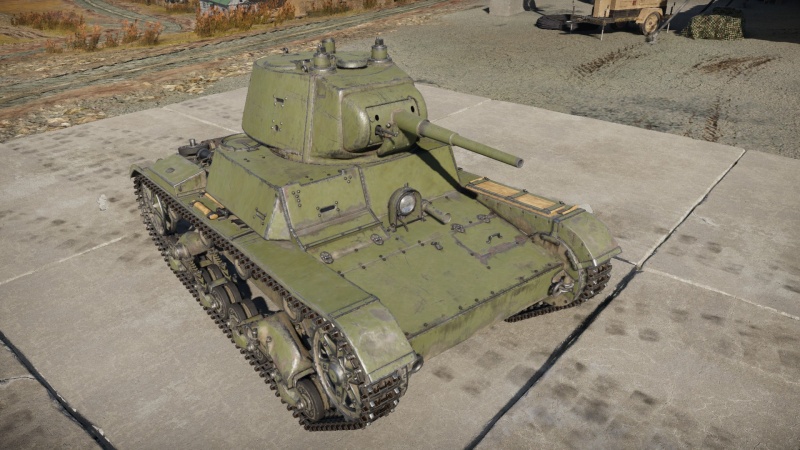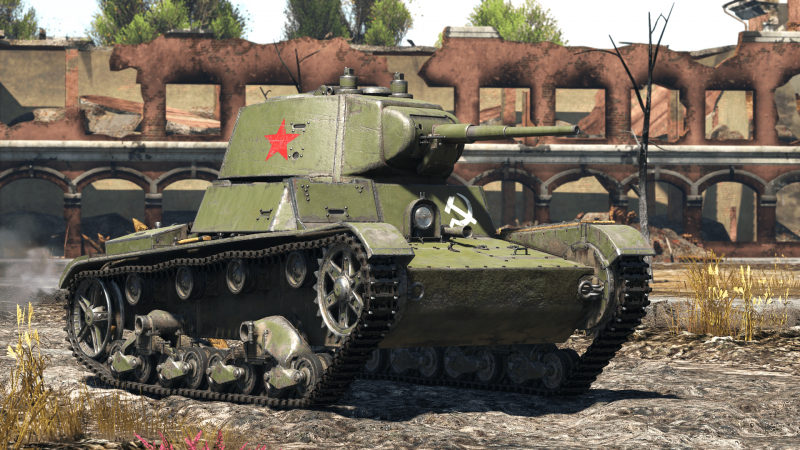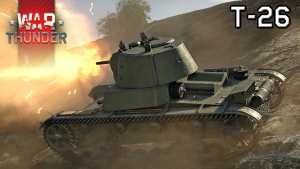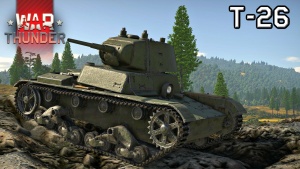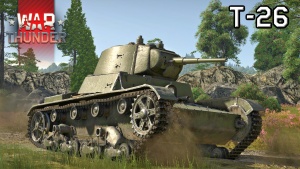T-26
| This page is about the Soviet light tank T-26. For other versions, see T-26 (Family). |
Contents
Description
The T-26 was based in the British Vickers 6 ton tank. Developed during the 1930s, the T-26 soon became the primary light tank of the Soviet Red Army. It saw combat during the Spanish Civil War and the Winter War, with mixed results due to poor leadership and tactics. Even though it was outclassed by the start of World War 2, it saw extensive use in the first year alongside the BT cavalry tanks, with heavy losses against the far superior Panzer III and Panzer IV. It was produced between 1931 and 1941, with different variants, command tanks, artillery variants, flamethrower tanks and many others, with a total sum of 12,000 units produced.
Introduced during the Closed Beta Test for Ground Forces before Update 1.41, the T-26 is a small vehicle with thin armour but a heavy-hitting 45 mm cannon that can devastate most enemies at its battle rating thanks to its APHE ammunition, with enough penetration and explosive filler to one shot most opponents. It has very poor armour like most light tanks, but it also has very poor mobility, being outmatched by tanks like the Panzer II and all BT models. It also suffers from the poor gun depression that characterizes all soviet tanks.
General info
Survivability and armour
The armour of the T-26 is thin, thus making the vehicle's survivability low. Armour is nearly flat on all sides, so it is recommended to not expose yourself to enemy fire. The crew members are not lined up behind each other from the front, meaning that enemies using AP solid shots may have to take up to 2-3 shots before knocking out all of your crew. Beware of heavy machine guns (common on American tanks) and autocannons (common on German and Italian tanks), since they will be able to both penetrate your armour and shred your crew/modules.
Armour type:
- Rolled homogeneous armour
| Armour | Front | Sides | Rear | Roof |
|---|---|---|---|---|
| Hull | 15 mm (22°) Front plate 7 mm (64-80°) Front glacis 15 mm (6-52°) Lower glacis |
15 mm (21-23°) Top 15 mm Bottom |
15 mm Top 15 mm (11°) Bottom |
10 mm Hull 6 mm Rear |
| Turret | 15 mm (13-15°) Turret front 15 mm (5-44°) Gun mantlet |
15 mm (17-19°) | 15 mm (17°) | 10 mm |
Notes
- Suspension wheel is 10 mm thick while tracks are 15 mm thick.
- Belly armour is 6 mm thick.
Mobility
| Game Mode | Max Speed (km/h) | Weight (tons) | Engine power (horsepower) | Power-to-weight ratio (hp/ton) | |||
|---|---|---|---|---|---|---|---|
| Forward | Reverse | Stock | Upgraded | Stock | Upgraded | ||
| Arcade | Expression error: Unexpected * operator. | 141 | Expression error: Unexpected round operator. | __.__ | |||
| Realistic | 80 | Expression error: Unexpected round operator. | __.__ | ||||
While being a light tank, its mobility is one of a medium/heavy tank. The top speed is very low for a light tank, combined with the low power to weight ratio given by its weak engine. The T-26 has poor acceleration and speed on most surfaces. It can reach around 30 km/h only on hard, flat surface, after a long, uninterrupted acceleration period. With even a small turn the speed will drop significantly. The narrow tracks significantly reduce its off-road mobility in muddy, sandy or snowy maps. Despite the tracks being short and far apart, the T-26 still has slow hull traverse and often needs a forward/backward jerk to start turning properly. Reverse speed is also very poor (-4 km/h), which cannot save you from most bad situations.
For new tankers, it is advised to choose between the T-26 and BT-5 wisely. Since they have very similar aspects (reserve light tanks with thin armour, the same gun, and a similar turret) they are good vehicles to compare and contrast opposing playstyles. The T-26 represents slow, patient, hunting and hiding while the BT-5 represents fast flanking and daring advances).
Modifications and economy
Armaments
Main armament
The 45 mm 20-K cannon is the typical Soviet gun at rank I. Players should get used to it since it will be their main light tank armament up until rank II. This gun is very forgiving to beginners, with its very fast reload speed, decent damage, and traverse speed.
| 45 mm 20-K | Turret rotation speed (°/s) | Reloading rate (seconds) | |||||||||||
|---|---|---|---|---|---|---|---|---|---|---|---|---|---|
| Mode | Capacity | Vertical | Horizontal | Stabilizer | Stock | Upgraded | Full | Expert | Aced | Stock | Full | Expert | Aced |
| Arcade | 205 | -6°/+22° | ±180° | N/A | 15.23 | 21.08 | 25.60 | 28.31 | 30.12 | 3.77 | 3.34 | 3.07 | 2.90 |
| Realistic | 9.52 | 11.20 | 13.60 | 15.04 | 16.00 | ||||||||
Ammunition
The APHEBC round has a good amount of HE filler, meaning penetrating shells will do good damage, sometimes even taking out enemies with a single shot. At longer ranges, shells begin to lose penetration and accuracy; it is not made for sniping. It is recommended to bring ~10-15 BR-240SP (armour-piercing shells without explosive filler) for heavier targets as they have more penetration.
| Penetration statistics | |||||||
|---|---|---|---|---|---|---|---|
| Ammunition | Type of warhead |
Penetration @ 0° Angle of Attack (mm) | |||||
| 10 m | 100 m | 500 m | 1,000 m | 1,500 m | 2,000 m | ||
| BR-240 | APHEBC | 70 | 67 | 58 | 47 | 39 | 32 |
| BR-240SP | APBC | 73 | 70 | 60 | 50 | 41 | 34 |
| Shell details | ||||||||||||
|---|---|---|---|---|---|---|---|---|---|---|---|---|
| Ammunition | Type of warhead |
Velocity (m/s) |
Projectile mass (kg) |
Fuse delay (m) |
Fuse sensitivity (mm) |
Explosive mass (TNT equivalent) (g) |
Ricochet | |||||
| 0% | 50% | 100% | ||||||||||
| BR-240 | APHEBC | 760 | 1.43 | 1.2 | 9 | 29.26 | 48° | 63° | 71° | |||
| BR-240SP | APBC | 757 | 1.43 | - | - | - | 47° | 60° | 65° | |||
Ammo racks
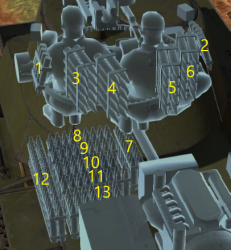
| Full ammo |
1st rack empty |
2nd rack empty |
3rd rack empty |
4th rack empty |
5th rack empty |
6th rack empty |
7th rack empty |
|---|---|---|---|---|---|---|---|
| 205 | 202 (+3) | 197 (+8) | 187 (+18) | 177 (+28) | 167 (+38) | 157 (+48) | 139 (+66) |
| 8th rack empty |
9th rack empty |
10th rack empty |
11th rack empty |
12th rack empty |
13th rack empty |
Visual discrepancy |
|
| 121 (+84) | 103 (+102) | 79 (+126) | 61 (+144) | 29 (+176) | 1 (+204) | No |
Note:
- Turret empty: 157 (+48) shells.
Machine guns
| 7.62 mm DT | ||||
|---|---|---|---|---|
| Mount | Capacity (Belt) | Fire rate | Vertical | Horizontal |
| Coaxial | 1,890 (63) | 600 | N/A | N/A |
Usage in battles
It is recommended to play the T-26 in a support role, flanking the battlefield and finding a good position to support your teammates from. The 45 mm cannon has very good characteristics with its rounds (APHEBC, AP) being able to deal a fair amount of damage to enemy vehicles from both short and long-range. The fast reload allows for quick adjustment of aim between shots, meaning the T-26 can be a highly effective flanking vehicle if a good camping spot is found. The limited gun depression, however, will affect which positions are usable. Keeping back at long-range is certainly an effective way to avoid taking damage.
The T-26 can also be used for brawling with enemy vehicles, but it should be kept in mind that the thin armour on the T-26 (≤15 mm) will leave the vital modules of your vehicle such as your crew, gun and powerplant (engine & transmission) at risk of taking damage. The mobility of the T-26 is also poorer than many of its counterparts, which could potentially put it at risk in a brawling scenario. On the other hand, the T-26's short reload time will usually give it an upper hand if you can survive the first shot.
Due to the top speed of the T-26 being slower than many other vehicles at its BR (30 km/h), it will usually arrive in the battlefield after the fighting has already begun. This can be an advantage in that you arrive after your team has already identified many targets. This also means that you will most likely not be on the front line of attack will usually allows for you to last a bit longer than players who rushed the center of the battlefield. On the other hand, it is also less likely that you will reach capture points before they are captured by your teammates, who will be faster than you.
The lack of armour is really something to be kept in mind, even some tank machine guns like the 12.7 mm M2HB and 13.2 mm Breda Model 31 will be able to go through your thickest plates of armour. Because of this, it is recommended to try your best to avoid enemy vehicles getting the first shot. Driving under cover is advisable to avoid being spotted.
In terms of the T-26's gun, there are 2 round options. The APHEBC round will penetrate most armour at the BR and also do a good amount of post-penetration damage if the fuse is set off. The second round type is an AP round with effective penetration but lacking any explosive filler, making its damage output inerior to the APHEBC round.
It is also worth keeping in mind that the T-26 only has a reverse speed of 3 km/h. This is important to remember when driving into potential enemy fire. It is recommended to be aware of enemy positions and cover, as a retreat will be a lot slower than an advance.
Be aware that enemy aircraft with bombs or powerful guns can easily take out the T-26. It is advised to stick to the treeline to avoid being spotted and attacked. The T-26 has little anti-aircraft capabilities so it is also advised to let the friendly SPAAs deal with aircraft.
- Specific enemies worth noting:
Pz.II - These speedy German tanks can be extremely dangerous. Their fast firing 20 mm autocannons can shred your armour and the modules behind it. Pz.IIs have better mobility than the T-26 to boot. Generally, it is advised not to engage head on but if you are forced to, then make sure you get off the first shot before they start spraying. These concerns are also shared with the Sd.Kfz. 140/1. The good thing about facing the Panzer II is that it doesn't have much armour, like most Rank I vehicles, so you can easily penetrate and knock it out with a single shot. Another tactic is to have a teammate with you, preferably a mobile light tank like the M22 or the BT-5. Your ally can distract the Panzer II while you line up your shot to take it out. Pz.IIs also have poor turret traverse speed, so getting behind it and shooting its engine can prevent it from bringing its gun to bear on you.
AB 41 and L6/40 - Italian counterparts to the German Pz.II series, these vehicles both feature 20 mm autocannons which present the same concerns and counters as the Pz.IIs. The difference is that the L6/40 is slightly slower than the Pz.IIs, while the AB 41 is significantly faster. Generally, if your round penetrates either vehicle, it will most likely do significant damage.
M2A2 - This unassuming and unusual American vehicle relies on a .50 cal (12.7 mm) M2HB heavy machine gun, located in its left-hand turret. The M2A2 shouldn't be dismissed as a threat however, as despite its odd layout, relatively small armament, and light armour, it is one of the fastest light tanks at Rank I. Given the T-26's relatively slow speed, the M2A2 will outflank you easily. Its .50 cal machine gun isn't always able to do a lot of damage to heavily armoured vehicles, but the T-26's is among the vehicles that the M2HB can consistently penetrate. When facing an M2A2, it is recommended to shoot first and stop it from closing the distance. If you are on its right side, it will have to turn towards you to bring its .50 cal to bear. Its 7.62 mm machine gun, located in its right turret, will not do any significant damage to the T-26.
M8 Scott and LVT(A)(4) - This American howitzer carrier takes the speedy hull of the M5 Stuart and mates it with a turret containing a 75 mm howitzer and a .50 cal M2HB. Being very fast, this tank can flank the T-26 very easily. It does not often need to do this however, since its HEAT round can annihilate the T-26 in one shot. It doesn't even need to do that however, since it could opt to just spraying your vehicle down with the .50 cal. By comparative principle, it is an M2A2 with a 75 mm. The LVT(A)(4) presents similar concerns, as it is marries the M8 Scott's turret to the hull of an LVT. Because of this, the LVT(A)(4) is able to swim. It is recommended to be watching the waterways, as most players do not expect an attack to come from areas that normal tanks cannot traverse.
Ka-Chi - This Japanese medium tank is often underestimated for its nation of origin, but it is not to be ignored. Its massive size may prevent your shells from doing significant damage in one shot, and some may occasionally be completely absorbed by the front pontoon or deflected if angled. Its height can allow it to see over your cover and spot you. It won't be able to lower its gun too far however, especially with floats attached, and if the T-26 is able to sneak around the Ka-Chi, you can potentially rush into the deadzone right alongside the vehicle and shoot into its flank, without chance of retaliation. It is recommended to be watching the waterways, as most players do not expect an attack to come from areas that normal tanks cannot traverse.
B1 bis and B1 ter - Nearly any Rank I vehicle unfortunate enough to come face-to-face with a B1 is in for a rough time. If the recommended tactic for the T-26 is being a support vehicle, it should be especially employed when a B1 is encountered. The B1 bis has thick armour that can absorb or deflect your 45 mm shells. The B1 ter presents the same issue for you, but even worse. There is little a T-26 can do when facing one of these heavy tanks head on, except for shooting the infamous "mail-slot" weak spot located on the turret ring, or damaging the tracks in hopes of immobilizing it. Calling in for friendly ground and air assistance is highly advised when encountering such beasts.
He 112 A-0 - This German plane is essentially a flying Panzer II. With a powerful rapid-firing 20 mm autocannon, it can use API-T rounds have enough penetration to go through the T-26 at nearly every angle. Experienced pilots can wreak havoc on your team until their ammo is expended. It is recommended to find solid roof cover when enemy aircraft are overhead.
SPAAs - Nearly every anti-aircraft vehicle at the tier, save for the British Light AA Mk I, will be able to penetrate and destroy the T-26 with ease. Not to mention that SPAAs guns have high rates of fire. As with any other vehicles, it is advised to shoot first. Certain SPAAs which are commonly underestimated like the French P.7.T AA, and CCKW 353 AA and the American M15 CGMC, and should be especially noted, as despite not having 20 mm autocannons like their Axis counterparts, they all have weapons capable of efficiently knocking out a T-26.
Pros and cons
Pros:
- Great firepower; the stock APHE shell can frontally penetrate and take out almost any tank with a single shot
- Very short reload time
- Fairly accurate gun at short to medium ranges
- Massive ammo capacity and fast reload time which is good for new players learning how to manoeuvre and fire
Cons:
- Low survivability due to the thin, nearly unsloped armour
- The crew members are packed tightly together, significantly reducing survivability
- Poor overall mobility: low top speed, very slow reverse speed, slow hull traverse, and difficulty in climbing steep slopes
- Average -5° gun depression limits its potential in hilly terrains
- Some ammo is stored inside turret which tends to explode when hit
History
Development
The T-26 light tank design is derived from the British Vickers 6-ton tank. In the early 1930s, a Soviet buying committee travelled to Britain and purchased tanks, tractors, and cars for use in the Soviet Union, of which the Vickers tank was chosen. Fifteen Twin-turreted Vickers tanks arrived in the Soviet Union in May 1930, equipped with only machine guns. Four more Vickers were delivered at the end of 1930, these being the single-turret variants with a 47 mm gun, and the deliveries were finished by 1932. The Vickers-produced tanks were designated as the V-26.
The Vickers 6-ton tank competed with several Soviet designs for the "most suitable" tank design for Soviet use. One such competitor was the Soviet T-19 light tank, which had advantages over the Vickers design, but also disadvantages. The T-19 designer, S. Ginzburg, suggested for a "hybrid" tank to be built off the features of the T-19 and the Vickers tank. But in January 1931, intelligence picked up that Poland bought up many foreign tanks from Britain and France with a license to mass-produce them. This information pressured the Soviet military council to adopt the foreign tanks into Soviet usage, thus the Vickers 6-ton tank, under the designation as the T-26, was accepted into service on February 13, 1931, as the mainstay of the Red Army's armoured forces.
Although outclassed later in the war, it was considered one of the more successful and widely produced tank models in the 1930s. It, along with the BT light tanks, composed the majority of Soviet armoured forces in the late 1930s. It weighed just a little under 10 tons, had 15 mm thick armour in front, with a 45 mm 20K gun, and had a crew of three people. The Bolshevik Factory in Leningrad was the first factory to start producing the T-26 from June 1931, and production of the tank lasted from then until 1941.
Variants
During its production life, many variants of it were made for different purposes, up to 53 different ones to fit different roles, though only 23 would see service in production. Such designs included changes like a twin-turreted version (some with only machine guns and some with cannons), command tanks, added armour, artillery tanks (such as the T-26-4), flamethrower tanks, remote-controlled tanks, or just armoured carriers to tow artillery and such. Others were simply modified variants of the normal variants such as the T-26E, which was the base single-turreted T-26 design with 30-40 mm applique armour made during the Winter War, which made them more resilient to the Finnish anti-tank weapons.
All these tanks produced in the span of 1931 to 1941 made up a total of 10,300 tanks, and 1,701 other variants of it, for a total of 12,001 units produced.
Combat usage
The T-26 first saw combat in the Spanish Civil War, where it showed its superiority over the current tanks of the period fielded by Italy and Germany. Then it saw combat against the Japanese in the Soviet-Japanese border conflicts at Lake Khasan and Khalkhin Gol, which exposed some of the design defects such as poor armour welding and the disadvantages of riveted constructions (the rivet would break off and could harm the crew inside). After that, the T-26 saw service in the Invasion of Poland and the Winter War against Finland. The Winter War effectively showed the Soviets that the T-26 was obsolete, as the 37 mm guns and anti-tank rifles and Finnish have could penetrate the light armour of the T-26. When World War II for the Soviet Union finally broke out in Operation Barbarossa, the T-26 proved inferior to Germany's Panzer III and Panzer IV, plus the air supremacy of the Luftwaffe ensured many tanks were lost in the opening stages of Barbarossa.
The T-26 at this point also was breaking down and the lack of spare parts made repairs hard, resulting in multiple T-26 units also being knocked out for being irrecoverable. The T-26 was gradually phased from service by the new, venerable T-34 medium tanks, which gave Germany a run for their money. The T-26 still saw service in the war as a second-line unit, as it was still fighting in the Battle of Moscow of 1941, Stalingrad of 1942, and in Manchuria in 1945.
Survivors
A number of survivors exist today in different museums, about 45 of them are still intact. A majority of them are in Russia, Spain, and Finland, where they saw most of their services.
| Archive of the in-game description | |
|---|---|
|
In 1940, the T-26 light tank was modernised for the last time. The vehicle's underturret boxes were equipped with homogeneous armour with sloping plates and its thickness was increased to 15 mm. The frontal section of the turret was welded. A distinctive feature of the tank was the special defensive cover over its radiator grille. An extra DT machine gun was mounted on the turret's roof and was used as an anti-aircraft gun. All these changes led to the T-26's mass exceeding 10 tonnes. In spite of its strengthened construction, its undercarriage was pushed to the limit. Often, particularly when turning, the tank started losing its tracks. Test results showed that the tank's armour did not meet modern requirements, and there was no weight allowance for increasing its armament. Other flaws in the tank's design included its low speed, poor weight distribution and low reliability. However, the tank was easy to control, simple to service and did not require much effort in the field. Although the tank had an engine with horizontally placed cylinders, the tank's profile remained low, which made it harder to hit. Many technical solutions applied to the T-26 were used later on other tanks. When used correctly and in the hands of an experienced crew, the light tank could cause serious damage to the enemy forces. The T-26 made a significant contribution to routing the enemy at Moscow and took part in practically all combat operations right up to 1944. A significant number of these tanks, after being captured and modified in various ways, served in the German and Finnish armies. Some of them were used by Finland until the beginning of the 50s. | |
Media
- Skins
- Videos
See also
- Vehicles equipped with the same chassis
- Other vehicles of similar configuration and role
External links
| Experimental Design and Mechanical Engineering Department | |
|---|---|
| Light Tanks | |
| T-26 | T-26 · T-26 (1st Gv.T.Br.) · T-26E · T-26-4 |
| T-50 | T-50 · T-126 |
| Heavy Tanks | T-35 |
| Tank Destroyers | SU-5-1 · SU-100Y |
| Export | |
| T-26 | ␗T-26 · T-26 No.531 |
| See Also | Omsk Transport Engineering Plant |
| USSR light tanks | |
|---|---|
| T-26 | T-26 · T-26 (1st Gv.T.Br.) · T-26-4 · T-26E |
| BT | BT-5 · RBT-5 · BT-7 · BT-7 TD · BT-7M · BT-7A (F-32) |
| T-50 | T-126 · T-50 |
| T-70 | T-70 · T-80 |
| PT-76 | PT-76B · PT-76-57 · Object 906 |
| BMP | BMP-1 · BMP-2 · BMP-2M · BMP-3 |
| BMD | BMD-4 |
| 2S25 | 2S25 · 2S25M |
| Wheeled | BA-11 · BTR-80A |
| Other | T-60 · Object 685 · 2S38 |
| China | ▂Type 62 |



